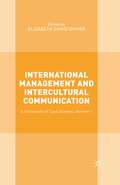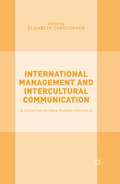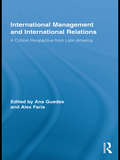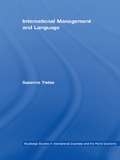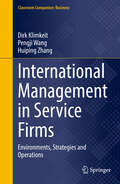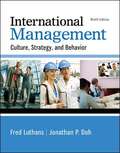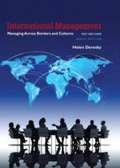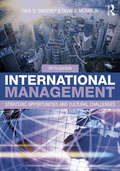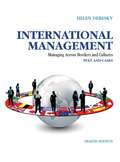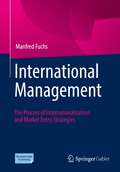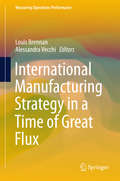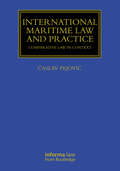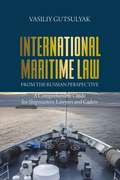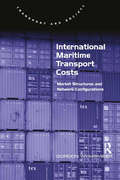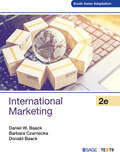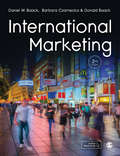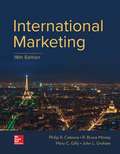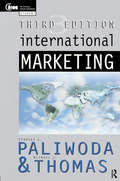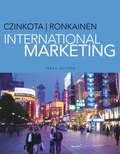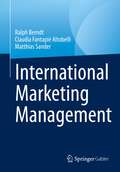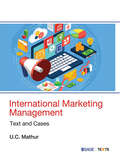- Table View
- List View
International Management and Intercultural Communication: A Collection of Case Studies; Volume 1
by Elizabeth ChristopherInternational Management and Intercultural Communication consists of cases of direct observation and personal involvement in a wide variety of communication challenges in international management settings; and discusses them in terms of management theories. The cases explore interactions across national cultures and regional boundaries, demonstrating both traditional and unusual approaches to problems that sooner or later are likely to challenge all managers who operate internationally. The book is presented in two volumes. Volume 1 contains case studies concerning different aspects of international management and intercultural communication in business, marketing and politics. Volume 2 deals with cases of international management in social and educational settings.
International Management and Intercultural Communication: A Collection of Case Studies; Volume 2
by Elizabeth ChristopherInternational Management and Intercultural Communication consists of cases of direct observation and personal involvement in a wide variety of communication challenges in international management settings, and discusses them in terms of management theories. The cases explore interactions across national cultures and regional boundaries, demonstrating both traditional and unusual approaches to problems that sooner or later are likely to challenge all managers who operate internationally. The book is presented in two volumes. Volume 1 contains case studies concerning different aspects of international management and intercultural communication in business, marketing and politics. Volume 2 deals with cases of international management in social and educational settings.
International Management and International Relations: A Critical Perspective from Latin America (Routledge Studies in Management, Organizations and Society)
by Ana GuedesOver the last few decades, the field of management enlarged its boundaries, especially in international terms, in a very rapid fashion—mainly because of the arrival of the so-called era of globalization. Many renowned scholars have criticized the universal approach given to ‘management’ in the United States and its subsequent automatic conversion into ‘international management,’ but their arguments too can fall into the trap of universalism at times. This book has a more specific concern: to challenge the conversion of ‘management’ into ‘international management’ from a Latin American perspective. This challenge might be taken as a first step toward the construction of a Latin American perspective in International Management and a potential contribution to the development of this field in other parts of the world. Drawing upon such critical standpoint, several authors in the book converge upon the idea that researchers, practitioners and authorities in Latin America should challenge the US dominance in International Management and foster interdisciplinary developments within International Relations. The critical perspective provided in this book challenges the US’s narrow viewpoint on management as it clearly does not fit the governance features of ‘international management’ in Latin America. So far, we have not observed the constitution of sub-areas such as international management of international organizations, international management of transnational institutions, international management of public-private networks, international management of public companies, and international public administration or international public management, all of which would be extremely important in Latin America.
International Management and Language (Routledge Studies in International Business and the World Economy #Vol. 41)
by Susanne TietzeGlobalization processes have resulted in the emergence of business and management networks in which the sharing of knowledge is of crucial importance. Combining two contemporary and important subject areas – namely that of international management and also language and communication in multi-language contexts – the author of this book presents a wealth of ideas, examples and applications taken from international and global contexts, which show that ‘language matters’ in the pursuit of international business affairs. The book establishes the theoretical core of its main ideas by introducing two orientations (social construction and linguistic relativity) and demonstrates how they can be drawn on to frame and understand the activities of managers. Highly innovative and topical, Susanne Tietze’s book will appeal to students of international management and international human resource management as well as those studying intercultural communication. It is also useful for managers and practitioners who work internationally.
International Management in Service Firms: Environments, Strategies and Operations (Classroom Companion: Business)
by Dirk Klimkeit Pengji Wang Huiping ZhangThis textbook examines how service firms manage their international operations. For the first time, it brings together insights from the fragmented literature on this subject into an accessible textbook. Further, it is unique in its focus on service firms’ internationalization and international management. Beginning with an overview of the international environment in which service firms operate, it subsequently describes multinational service firms and their internationalization processes, strategies and organization. Unlike most texts on international services, the book goes beyond internationalization to address the ongoing management of service firms. It not only addresses functions such as global service marketing, financial management and human resource management, but also discusses aspects such as global account management, global service delivery and international project management, as well as the topical issue of managing distributed virtual teams. A dedicated chapter focuses on offshore shared services and business process outsourcing. These chapters are complemented by a discussion on international corporate governance and corporate social responsibility. The book is intended for students preparing for international careers in the service sector. Each chapter includes case studies, illustrations, highlighted definitions, a chapter summary and exercises.
International Management: Culture, Strategy, and Behavior (Ninth Edition)
by Fred Luthans Jonathan P. DohInternational Management: Culture, Strategy, and Behavior reflects new and emerging developments influencing international managers. With integrated real-world examples, research, and practical applications, students understand how to adjust, adapt, and navigate the changing global business landscape and respond to global challenges - making it a market - leader. The authors retain research and practices over the past decades, and incorporate new and emerging developments affecting international managers to increase students' effectiveness in managing across cultures.
International Management: Insights from Fiction and Practice
by Sheila M. PufferExploring topics covered in international management courses, this book pairs business articles and fictional short stories to provide practical guidelines and concrete examples and convey cultural subtleties and shades of meaning.
International Management: Managing Across Borders and Cultures, Text and Cases (Ninth Edition)
by Helen DereskyFor courses in international business, international management, and general management. International Business is conducted around the globe across cultures, languages, traditions, and a range of economic, political, and technological landscapes. International Management: Managing Across Borders and Cultures examines the challenges to the manager's role associated with adaptive leadership and thoroughly prepares readers for the complicated yet fascinating discipline of international and global management. No matter the size, companies operating overseas are faced with distinct scenarios. In order to be successful, they must accurately assess the components that shape their strategies, operations and overall function. The Ninth Edition trains readers and practicing managers for careers in this evolving global environment by exposing them to effective strategic, interpersonal, and organizational skills, while focusing on sustainability.
International Management: Strategic Opportunities and Cultural Challenges
by Dean B. Mcfarlin Paul D. SweeneyAs the economies of many countries become more interrelated, international managers are facing huge challenges and unique opportunities associated with their roles. Now in its fifth edition, Sweeney and McFarlin's International Management embodies a balanced and integrated approach to the subject, emphasizing the strategic opportunities available to firms on a global playing field, as well as exploring the challenges of managing an international workforce. Integrating theory and practice across all chapter topics, this book helps students to learn, grasp, and apply the underlying principles of successful international management: Understanding the broad context of international business, including the critical trends impacting international management, the legal and political forces driving international business, and the ethical and cultural dilemmas that can arise Mastering the essential elements of effective interaction in the international arena, from cross-cultural understanding and communication to cross-border negotiation Recognizing and taking advantage of strategic opportunities, such as entering and operating in foreign markets Building and leading effective international teams, including personal and behavioral motivation, as well as taking an international perspective on the hiring, training, and development of employees These principles are emphasized in the text with current examples and practical applications, establishing a foundation for students to apply their understanding in the current global business environment. With a companion website featuring an instructor's manual, powerpoint slides, and a testbank, International Management, 5e is a superb resource for instructors and students of international management.
International Management: Text and Cases (Eighth Edition)
by Helen DereskyThe eighth edition of International Management: Managing Across Borders and Cultures prepares students and practicing managers for careers in a dynamic global environment wherein they will be responsible for effective strategic, organizational, and interpersonal management. While managing within international and cross-cultural contexts has been the focus of this text since the first edition, the eighth edition portrays the burgeoning level, scope, and complexity of international business facing managers in the twenty-first century. The eighth edition explores how recent developments and trends within a hypercompetitive global arena present managers with challenging situations; it guides the reader as to what actions to take, and how to develop the skills necessary to design and implement global strategies, to conduct effective cross-national interactions, and to manage daily operations in foreign subsidiaries.
International Management: The Process of Internationalization and Market Entry Strategies
by Manfred FuchsThis textbook for students and practitioners offers answers to the most important questions and challenges of international management. The main topics are presented and discussed on three levels: (a) the macroeconomic and institutional environment of the global economy, (b) the international firms embedded as players in this environment, and (c) the actual management decisions. The focus is placed both on the characteristics of the individual subject areas (macro-, meso- and microperspective) and on the interdependent connections between these areas. The main interest of this book lies in an application-oriented analysis of the central strategic management decisions in internationalizing companies.This textbook has been recommended and developed for university courses in Germany, Austria and Switzerland.
International Manufacturing Strategy in a Time of Great Flux
by Louis Brennan Alessandra VecchiThis book assesses the state of international manufacturing strategy and clarifies how recent developments, for example regarding configuration, technology, and the environment, are impacting on its content and direction and on its relationship to manufacturing performance. In providing up-to-date coverage of the consequences of such forces and factors for international manufacturing, this book aims to expand the debate concerning international manufacturing strategy and cast light on its current evolution. International manufacturing is operating within a time of great flux. While offshoring of activities has dominated over recent decades, nearshoring and reshoring are increasingly being considered and observed in practice. At the same time, technologies such as 3D-printing are gaining traction and the role of ICT and data analytics is increasingly important in the international manufacturing landscape while digitization becomes more prevalent and the embrace of the Internet of Things (IOT) accelerates. Furthermore, issues related to the environment are figuring more prominently in international manufacturing considerations, and assumptions regarding the long-term cost of energy are being called into question. International manufacturing is also experiencing greater servitization.
International Maritime Law and Practice: Comparative Law in Context (Maritime and Transport Law Library)
by Časlav PejovićThis book provides a different perspective on the ever-popular topic of maritime law, emphasising historical and comparative aspects. It provides the reader with a broader view of how maritime law has developed throughout history and operates within various legal systems. Each chapter starts with historical development, meticulously explaining the development of various maritime law concepts to enable a higher level of understanding in the contemporary context.The text adopts a comprehensive comparative approach that has two segments. One segment is related to the coverage of several major maritime jurisdictions. Focusing mainly on English law, it also provides selected legislation and essential case law information from several other jurisdictions (US, France, Germany, Italy, Japan, China, etc), many of which are not easily accessible in English. The other relates to the comparison between common law and civil law on a general level.This book will be of significant interest to lawyers working in shipping companies, law firms specializing in shipping, international organizations related to shipping and maritime law, and international traders. It also provides invaluable aid to shipmasters and ship officers, empowering them with the knowledge to effectively deal with various maritime law issues in their professional activities. The book's content will be of direct relevance to maritime law scholars and students, enhancing their understanding of this complex field.
International Maritime Law from the Russian Perspective: A Comprehensive Guide for Shipmasters, Lawyers and Cadets
by Vasiliy GutsulyakThis book is one of the most comprehensive guides to international maritime law from the Russian perspective. It consists of three relatively independent sections: Russian Maritime Law, International Public Maritime Law, and International Private Maritime Law.°First section discusses the development of the maritime law as a branch of the Russian law. It examines concepts and sources of the Russian federal laws, secondary legislation and customs, including the influences guiding the future of Russian law of the sea.°The second section examines International Public Maritime Law including the principles, sources, subjects, as well legal status of the vessel, including the vessel's state flag, her name, state registration, the problem of "flags of convenience", vessel's documents, the crew, and the master. This section further details the current international legal regime of maritime spaces, provisions concerning legal protection of marine environments, ensuring navigation safety, international legal regulation of the work of seamen, international inter-governmental marine organizations, and settlement of international public marine disputes.°The third section is devoted to International Private Maritime Law and discusses its principles and sources, conflict-of-law rules, structure and types, and the main choice-of-law principles used today in international private maritime law. This section also discusses the following institutions and sub-branches within international private maritime law including: carriage of cargoes and passengers by sea, general average, salvage, collisions of vessels, marine insurance, limitation of liability, international non-governmental maritime organizations, and settlement of international private marine disputes.
International Maritime Transport Costs: Market Structures and Network Configurations (Transport And Society Ser.)
by Gordon WilmsmeierBased on in-depth empirical research, this book develops our understanding of maritime transport costs, the maritime industry and the competitiveness of regions in a global market environment through a geographical lens. Further, the book uses a unique set of data that gives an extensive insight into Latin American international maritime transport costs and its determinants. This is a clear call for policy makers and port authorities to strengthen transnational cooperation in order to improve the development of the whole system of maritime transport, focusing on the causes that put regions at risk of becoming peripheral and uncompetitive.
International Maritime Transport: Perspectives (Routledge Advances in Maritime Research)
by Heather Leggate James McConville Alfonso MorvilloThe importance of the international maritime transport industry is difficult to overstate. This new book presents an interdisciplinary approach from a wide range of internationally-based experts. International Maritime Transport represents a radical departure from previous works in its structure and approach. The section editors each discuss the state of the art in the opening chapter, before introducing a selection of works providing a wide-ranging analysis of the subject. Wide discretion of approach has provided literary freedom for individual opinion and analysis within the overall framework: this permits a level of innovation which is perhaps stifled by the more standardized model. Whilst each perspective can be seen as exclusive, together they form a comprehensive volume of issues in contemporary maritime transport. Topics covered include: ports as interfaces, logistics, manpower and skills, financial risk and opportunities, the regulatory framework. Each chapter contains an introduction which explains the context of the chapter within the book and the contemporary state of the art. Under the editorship of maritime experts James McConville, Alfonso Morvillo and Heather Leggate, the book is sure to be of interest to students and academics working on maritime studies, as well as being useful to professionals and policy makers in the maritime industry.
International Marketing
by Donald Baack Barbara Czarnecka Daniel W. BaackInternational Marketing discusses the core concepts of marketing in-depth in a global context. In this new edition the authors discuss marketing in a globalised world using an integrated approach, incorporating theory and real-world case studies. The book explores five key factors that impact marketing - culture, language, political/legal systems, economic systems, and technological differences alongside the core concepts of markets, products, pricing, distribution (place), and promotion. The book also tackles contemporary issues in the world of marketing. It takes examples from both multinational companies and smaller businesses to cover sustainability and bottom-of-pyramid issues. It will be an invaluable asset for students as well as professionals who want to understand the world of international marketing. Key Features: • Brand new chapter on Culture and Cross-Cultural Marketing, including political unrest and the recent return to nationalism and further coverage of developing countries • New coverage of digital advances and social media marketing • Updated theory and methods, including Service Dominant Logic (S-DL), Consumer Culture Theory (CCT), and Netnography • More global focus through new examples and case studies
International Marketing
by Donald E. Baack Professor Daniel W. Baack Dr Barbara CzarneckaA marketing first approach to exploring the inter-relatedness of the key components that impact any international marketing venture – markets, the 4Ps, culture, language, political, legal and economic systems, and infrastructure - to support an understanding of the synergies between international marketing and international business. The book covers the incorporation of sustainability and bottom-of-the-pyramid markets within each chapter, along with ‘International Incident’ boxes encouraging the reader to engage with the ethical and cultural dimensions of international marketing and decision-making. It is also supported by vivid, real-world case studies from a varied cross section of international companies such as Alibaba.com, Best Buy, Facebook, DHL, Kikkoman, Tesco, McDonalds, Nintendo, KitKat in Japan, Mobile Communications in Africa, India’s ArcelorMitall Steel, Wind Turbines in Finland, Uniqlo, and Banana Republic. New to this edition: A more global focus through examples, case studies and the experience brought by new co-author Barbara Czarnecka Chapter on “Culture and Cross-Cultural Marketing”, featuring political unrest, the Syrian refugee crisis, the recent return to nationalism (e.g. Brexit and the Trump presidency) and further coverage of developing countries. Chapter feature, “Practitioner Insight”, which provides applied insights from industry insiders. Coverage of digital advances and social media. Updated theory and methods, including S-DL, CCT, and Netnography. Additional videos supplementing the comprehensive online resource package for students and lecturers. A wealth of online resources complement this book. These include a test bank of 50-65 questions per chapter, PowerPoint slides, sample syllabi, interactive maps, country fact sheets, flashcards, SAGE journal articles, and guidelines for developing a marketing plan. Suitable reading for students of international or global marketing modules on Marketing, International Business and Management degrees.
International Marketing
by Donald E. Baack Professor Daniel W. Baack Dr Barbara CzarneckaA marketing first approach to exploring the inter-relatedness of the key components that impact any international marketing venture – markets, the 4Ps, culture, language, political, legal and economic systems, and infrastructure - to support an understanding of the synergies between international marketing and international business. The book covers the incorporation of sustainability and bottom-of-the-pyramid markets within each chapter, along with ‘International Incident’ boxes encouraging the reader to engage with the ethical and cultural dimensions of international marketing and decision-making. It is also supported by vivid, real-world case studies from a varied cross section of international companies such as Alibaba.com, Best Buy, Facebook, DHL, Kikkoman, Tesco, McDonalds, Nintendo, KitKat in Japan, Mobile Communications in Africa, India’s ArcelorMitall Steel, Wind Turbines in Finland, Uniqlo, and Banana Republic. New to this edition: A more global focus through examples, case studies and the experience brought by new co-author Barbara Czarnecka Chapter on “Culture and Cross-Cultural Marketing”, featuring political unrest, the Syrian refugee crisis, the recent return to nationalism (e.g. Brexit and the Trump presidency) and further coverage of developing countries. Chapter feature, “Practitioner Insight”, which provides applied insights from industry insiders. Coverage of digital advances and social media. Updated theory and methods, including S-DL, CCT, and Netnography. Additional videos supplementing the comprehensive online resource package for students and lecturers. A wealth of online resources complement this book. These include a test bank of 50-65 questions per chapter, PowerPoint slides, sample syllabi, interactive maps, country fact sheets, flashcards, SAGE journal articles, and guidelines for developing a marketing plan. Suitable reading for students of international or global marketing modules on Marketing, International Business and Management degrees.
International Marketing
by John L. Graham Philip R. Cateora R. Bruce Money Mary C. GillyInternational Marketing addresses global issues and describes concepts relevant to all international marketers, regardless of the extent of their international involvement. The text will stimulate curiosity about management practices of companies, large and small, seeking market opportunities outside the home country and to raise the reader's consciousness about the importance of viewing international marketing management strategies from a global perspective. Although this revised edition is infused throughout with a global orientation, export marketing and the operations of smaller companies also are included. Issues specific to exporting are discussed where strategies applicable to exporting arise, and examples of marketing practices of smaller companies are examined.
International Marketing
by Michael Thomas Stanley PaliwodaThe third edition of an established text, this book provides comprehensive treatment of international marketing issues and includes expanded coverage of Eastern Europe and the Pacific Rim.New for this edition are the expanded use of mini cases within the text to illustrate the latest developments in marketing, together with expanded coverage of: South East Asia and the Pacific Rim, Central and Eastern Europe, Globalization, Culture, Financial aspects of marketing.Included throughout are self-assessment and discussion questions, key terms, references and bibliography.
International Marketing (Tenth Edition)
by Ilkka A. Ronkainen Michael R. CzinkotaAn innovative, up-to-date text ideal for anyone seeking success in this fast-paced field. You will discover topics ranging from beginning start-up operations to confronting giant global marketers.
International Marketing (Tenth Edition)
by Vern Terpstra James Foley Ravi SarathyA comprehensive introduction to the field, designed and written as a resource for students of international marketing. The text now covers all the international marketing tasks and knowledge statements from the NASBITE Certified Global Business Professional (CGBP) certification. For students and practitioners seeking the CGBP qualification, this text will also serve as the most useful preparation for the international marketing portion of the exam.
International Marketing Management
by Ralph Berndt Matthias Sander Claudia Fantapié AltobelliFor every company that is active internationally, a systematically operated cross-national marketing management is indispensable in order to secure its own existence in the long term. The rapid changes on many markets and in many countries also mean that professional information gathering and processing of market-relevant data must take place within the framework of international market research. Based on this data, market-oriented decisions have to be made within international marketing management in order to achieve operational goals. This book deals not only with the "classic" topics of international marketing, such as international market research and the international use of individual marketing instruments, but also with the various management sub-functions of planning, controlling, organization and human resources management in internationally active companies, each with a specific reference to marketing in the sense of market-oriented corporate management. The theoretically presented correlations are enriched by current data on the relevant framework conditions on international markets, empirical findings on the individual fields of action of international marketing management as well as numerous current examples from entrepreneurial practice. With this comprehensive presentation of international marketing management, the authors address lecturers and students as well as practitioners who deal with marketing issues in an international context.
International Marketing Management: Text and Cases (SAGE Texts)
by U C MathurGiven the need for Indian managers to be fully aware of the issues related to International Marketing, this has emerged as a major study area over the last few years. It constitutes an integral part of the syllabi in most reputed business schools. International Marketing Management: Text and Cases attempts to make learning the nuances of the subject easy from the students` viewpoint. Some of its key features are: - An analysis of international trade, economic free trade zones, embargoes on exports, and the tariff and non-tariff barriers that companies face - The role of international organisations under the aegis of the United Nations in international marketing - The systems and the forms used in international marketing in India - A focus on the importance of stakeholders of a company for corporate survival - Highly developed and class-tested management games The interactive management games and carefully selected case studies provide hands-on corporate experience to students, making the book invaluable for those pursuing MBA, BBA and MIB programmes. It would also be of interest to corporate marketing heads and others in the field of marketing.
